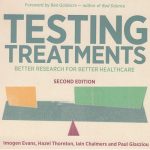
McMaster Evidence-Based Clinical Practice Workshop Resources – Therapy module
McMaster Evidence-Based Clinical Practice Workshop – Therapy module.
| 0 Comments
McMaster Evidence-Based Clinical Practice Workshop Resources – Systematic review module
McMaster Evidence-Based Clinical Practice Workshop – Systematic review module.
| 0 Comments
What is meant by intention to treat analysis? Survey of published randomised controlled trials
Results of a survey to document the meaning of ‘intention to treat’ analysis.
| 0 Comments
The interpretation of clinical trials
Peter Greenberg’s 9-minute read on the interpretation of clinical trials.
| 0 Comments
Assessing Risk of Bias in Included Studies
An introduction to assessing risk of bias using the Cochrane ‘Risk of Bias Tool’.
| 0 Comments
University of Western Australia: Bias Minimisation, randomisation and blinding
University of Western Australia’s explanation of why random allocation to comparison groups and blinding (if possible) are important.
| 0 Comments
What is a meta-analysis? How to use a systematic review
Oxford University’s Centre for Evidence-Based Intervention guide on how to use evidence from systematic reviews.
| 0 Comments
Do the statistics back up the claim?
‘Ask for Evidence’ introduction to the interpretation and assessment of statistics.
| 0 Comments
Is the trial valid?
An article from the PEDro database on assessing the validity of a study.
| 0 Comments
Goals and tools in Prognosis evaluation
How to assess prognosis in Michigan State University’s Evidence-Based Medicine Course.
| 0 Comments
Evaluating the validity of a therapy study
A web-based Duke University tutorial explaining how to address the question: are the results of the study valid?
| 0 Comments
‘Tricks to help you get the result you want from your study (S4BE)
Inspired by a chapter in Ben Goldacre’s ‘Bad Science’, medical student Sam Marks shows you how to fiddle research results.
| 0 Comments
Strictly Cochrane: a quickstep around research and systematic reviews
An interactive resource explaining how systematic and non-systematic reviews differ, and the importance of keeping reviews up to date.
| 0 Comments
Bias – the biggest enemy
University of New South Wales Medical Stats Online Tutorial 5 addresses ‘Bias - the biggest enemy’.
| 0 Comments
Appraising the evidence
Six key slides produced by the University of Western Australia to introduce critical appraisal.
| 0 Comments
Critical appraisal of clinical trials
Slides developed by Amanda Burls for an interactive presentation covering the most important features of well controlled trials.
| 0 Comments
Tips for understanding Intention-to-Treat analysis
Ignoring non-compliance with assigned treatments leads to biased estimates of treatment effects. ITT analysis reduces these biases.
| 0 Comments
Defining Bias
This blog explains what is meant by ‘bias’ in research, focusing particularly on attrition bias and detection bias.
| 0 Comments
Data Analysis Methods
A discussion of 2 approaches to data analysis in trials - ‘As Treated’, and ‘Intention-to-Treat’ - and some of the pros and cons of each.
| 0 Comments
Making sense of randomized trials
A description of how clinical trials are constructed and analysed to ensure they provide fair comparisons of treatments.
| 0 Comments
Compliance with protocol and follow-up in clinical trials
Denis Black’s 10-min, downloadable, PowerPoint presentation on compliance, follow up, and intention-to-treat analysis in clinical trials.
| 0 Comments
The need to compare like-with-like in treatment comparisons
Allocation bias results when trials fail to ensure that, apart from the treatments being compared, ‘like will be compared with like'.
| 0 Comments

Attrition bias, publication bias, comparator bias and commercial bias
6 slides and a 3-min commentary on attrition bias, publication bias, comparator bias and commercial bias (from Univ Mass Med School).
| 0 Comments
Randomized Controlled Trial Protocols
A 1-hour videoed lecture explaining protocols for Randomized Control Trials (RCTs).
| 0 Comments
Methodology of clinical trials
Eurordis training on the methodology of clinical trials for representatives of patients’ organisations.
| 0 Comments
การตามสังเกตทุกคนที่อยู่ในการเปรียบเทียบวิธีการรักษา
หลังจากอุตส่าห์จัดกลุ่มเปรียบเทียบเพื่อให้แน่ใจว่าสิ่งที่เปรียบเทียบคล้ายคลึงกัน ยังต้องเลี่ยงไม่ให้เกิดความลำเอียงจากการละเลย ความเปลี่ยนแปลงในผู้ป่วยบางส่วน ควรตามสังเกตผู้ป่วยทุกรายให้นานที่สุด และวิเคราะห์ผลในภาพรวมของผู้ป่วยทุกรายที่อยู่ในกลุ่มนั้นๆ โดยไม่สนใจว่าพวกเขาได้รับวิธีการรักษาใด (ถ้าได้รับ) การทำแบบนี้เรียกว่าการวิเคราะห์ “intention-to-treat” ถ้าไม่ทำ ดังนี้ สิ่งที่เปรียบเทียบจะไม่อาจเทียบเคียงกันได้ ดูเผินๆ อาจคล้ายไม่สมเหตุสมผลที่เปรียบเทียบระหว่างกลุ่ม ทั้งที่ผู้ป่วยบางรายในกลุ่มไม่ได้รับวิธีการรักษาที่กำหนดให้แล้ว แต่การละเลยหลักการนี้อาจทำให้การตรวจสอบไม่เที่ยงธรรมและให้ผลชวนเข้าใจผิด เช่น ผู้ป่วยที่หลอดเลือดเลี้ยงสมองเริ่มตีบและเวียนศีรษะเป็นช่วงๆ เสี่ยงจะเป็นโรคหลอดเลือดสมองสูงกว่าปกติ นักวิจัยทำการตรวจสอบว่าหลังจากทำหัตถการเพื่อแก้การตีบในผู้ป่วยกลุ่มนี้ […]
| 0 CommentsNo Resources Found
Try clearing your filters or selecting different ones.
